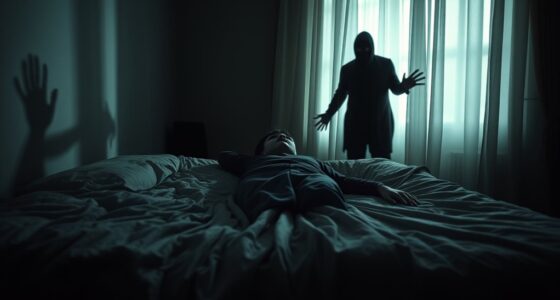During hypnagogia and hypnopompia, your brain shifts between wakefulness and sleep, causing vivid hallucinations and fleeting thoughts. Brain waves shift from beta to alpha and theta frequencies, while neural circuits loosen their usual filters. The default mode network kicks in, fostering spontaneous imagery and creativity. Neurochemistry also plays a role, influencing hallucination vividness. Understanding these liminal states reveals how your mind explores subconscious domains—if you stay curious, there’s more fascinating science to uncover.
Key Takeaways
- Hypnagogia and hypnopompia are transitional brain states involving shifts from wakefulness to sleep and vice versa, characterized by vivid hallucinations.
- During these states, brain waves transition from high-frequency beta to slower alpha and theta waves, reflecting neural reorganization.
- Loosening of neural filters and decreased prefrontal cortex activity allow subconscious thoughts and sensory perceptions to surface.
- The default mode network becomes highly active, promoting spontaneous imagery, creative insights, and hallucinations.
- Neurochemical fluctuations, such as serotonin and acetylcholine levels, influence the vividness and nature of hallucinations during these liminal states.

As you drift between wakefulness and sleep, your brain enters unique states known as hypnagogia and hypnopompia, which are responsible for vivid dreams, hallucinations, and fleeting thoughts. These liminal states occur during the sleep transition processes, a period characterized by rapid changes in brain activity that neuroscience insights have begun to unravel. During hypnagogia, as you move from alertness into sleep, your brain shifts from high-frequency beta waves to slower alpha and theta waves. This change isn’t abrupt; instead, it involves a gradual reorganization of neural circuits, leading to the surreal experiences you might notice—images popping up, sounds blending, or a sense of floating. Neuroscientists understand that this phase is marked by a temporary loosening of the brain’s usual filtering mechanisms, allowing random or subconscious thoughts to surface more freely. Neural circuitry plays a crucial role in shaping these transient mental states, highlighting the dynamic processes at work during sleep onset.
During hypnagogia, brain waves shift gradually, allowing subconscious thoughts and vivid images to surface freely.
Similarly, as you wake up and shift from sleep to consciousness, hypnopompia occurs. During this phase, your brain re-engages with the external world, but remnants of the hypnagogic state may linger, causing hallucinations or vivid memories. Neuroscience insights suggest that during sleep transition processes, specific neural pathways are activated or suppressed, which explains why these hallucinations often feel so real. For example, the prefrontal cortex—responsible for logical reasoning—is still less active, while sensory areas remain unusually receptive. This imbalance contributes to the dreamlike quality of hypnagogic and hypnopompic experiences, making them feel both familiar and strange.
The brain’s default mode network (DMN), which is associated with daydreaming and internal thought, also plays a key role. During these liminal states, the DMN becomes highly active, facilitating spontaneous imagery and creative associations. This explains why many people experience flashes of insight or inspiration during hypnagogia. Additionally, the sleep transition processes involve fluctuations in neurotransmitter levels, such as serotonin and acetylcholine, which influence how vivid or bizarre your hallucinations might be. These neurochemical dynamics are precisely what neuroscience insights focus on, revealing the complex interplay behind these ephemeral mental states.
In essence, hypnagogia and hypnopompia are natural, fascinating phases rooted in the brain’s intricate sleep transition processes. They highlight how your neural circuitry works during the delicate boundary between wakefulness and sleep, offering a window into the subconscious mind. Understanding these processes through neuroscience insights not only demystifies these experiences but also underscores their significance in creativity, problem-solving, and mental health.
Frequently Asked Questions
Can Hypnagogic States Be Intentionally Induced?
Yes, you can intentionally induce hypnagogic states by practicing relaxation and focused awareness. Techniques like meditation and sensory gating help you enter these liminal states more easily. During hypnagogia, you might experience vivid imagery, similar to lucid dreaming, which can be harnessed for creativity or self-exploration. Consistent practice enhances your ability to access these states at will, allowing you to explore the boundary between wakefulness and sleep.
Are Hypnagogia and Hypnopompia Unique to Humans?
Imagine crossing a shimmering, moonlit bridge between dreams and waking life—that’s what hypnagogia and hypnopompia evoke. These states aren’t unique to humans; many animals experience sensory dissociation during sleep, hinting at a shared, primal connection to dream incubation. You might not realize it, but as you drift, your mind navigates this liminal space, revealing a universal dance between consciousness and the subconscious, across all sentient beings.
How Do These States Relate to Creativity?
You can harness hypnagogia and hypnopompia to boost your creativity by practicing dream incubation, where you focus on ideas before sleep, enhancing artistic inspiration. These liminal states open your mind to novel connections and insights, making it easier to generate original ideas. By intentionally entering these states, you tap into subconscious creativity, transforming fleeting thoughts into innovative projects or artistic expressions.
Can They Be Linked to Mental Health Conditions?
You might find that hypnagogic and hypnopompic states are linked to mental health conditions, especially with experiences like vivid dream symbolism or sleep paralysis. These states can sometimes trigger anxiety or panic, or intensify existing conditions like depression or PTSD. By understanding these connections, you can better recognize how your sleep experiences influence mental health, and seek appropriate support if these states cause distress or interfere with daily life.
Do Different Cultures Interpret These States Differently?
Yes, different cultures interpret hypnagogic and hypnopompic states uniquely. You might find that cultural symbolism shapes how these experiences are understood, often linking them to spiritual practices or ancestral beliefs. For example, some cultures see these states as portals to spiritual domains, while others view them as natural passages. Your cultural background influences whether you see these liminal states as mystical, psychological, or both.
Conclusion
As you explore hypnagogia and hypnopompia, remember that nearly 70% of people experience vivid, dream-like thoughts during these states. These liminal moments aren’t just fascinating—they can spark creativity, problem-solving, and self-awareness. By understanding the science behind these shifts, you gain insight into your mind’s incredible flexibility. So next time you drift between wakefulness and sleep, embrace these fleeting experiences—they’re a gateway to your subconscious depths.









